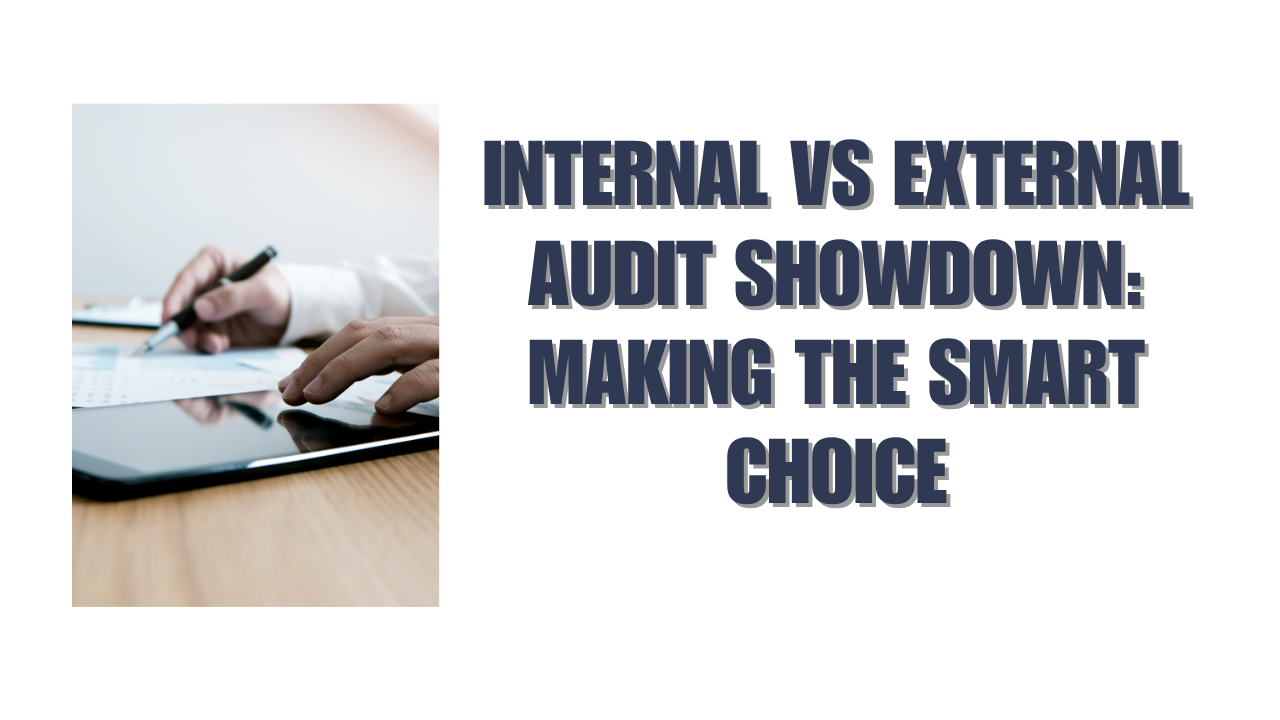Your choice between internal vs external audit can dramatically affect your organization’s finances. The core team in the most effective auditing departments costs companies just $0.13 per $1,000 in revenue. These expenses can shoot up to $3.06 per $1,000 if you’re not careful. That’s a staggering 23-fold difference!
The difference between internal and external auditors runs deeper than just costs. Internal auditors work as company employees and focus on year-round improvements. External auditors belong to outside firms that conduct yearly financial reviews. This basic contrast affects everything from scope to reporting structures. Public companies spend an average of $2.52 million on external audits. Even nonprofits shell out $10,000 to $20,000 with their simpler financial structures.
Companies that make smart audit choices see real benefits quickly. They use advanced audit technologies to cut down external audit prep time by weeks. These technologies help catch financial issues before they turn into problems. You need to understand each audit type’s strengths and limits to make the right choice for your operational efficiency, compliance needs, or financial statement credibility.
In this piece, we’ll explore the main differences between these audit approaches. We’ll get into their specific purposes and help you pick the strategy – or combination – that fits your organization’s needs best.
Understanding Internal and External Audits
Organizations depend on audits for oversight, and we need to understand the difference between internal vs external audit roles and frameworks.
Definition and Purpose of Internal Audit
Internal auditing serves as an independent, objective assurance and consulting activity that adds value to operations. It helps businesses reach their goals through a systematic approach to assess and improve risk management, control, and governance processes. The main goal is to provide assurance that risk management, governance, and internal controls work effectively.
Internal auditors help organizations create, protect, and sustain value by giving the board and management independent, risk-based advice. Their scope extends beyond finances to cover cybersecurity, supply chains, ESG-related risks, corporate culture, and diversity initiatives.
Definition and Purpose of External Audit
An independent third party conducts external audits to assess an organization’s financial statements. These audits give stakeholders – shareholders, regulators, and others – confidence that financial reports are accurate and meet regulations.
External auditors test financial accounts to verify that statements reflect the organization’s true financial position. Their unbiased assessment builds trust between companies and stakeholders. The process looks at accounting records, policies, procedures, and internal controls.
Key Roles: Internal vs External Auditors
Internal auditors report to the board’s audit committee while maintaining ties with senior management. They act as trusted advisors who look at how organizations operate, what they want to achieve, and how current systems support these goals.
External auditors must stay completely independent from the organization they audit. Their core focus is to determine whether financial statements are free of material misstatements.
The biggest difference lies in their relationship with organizations. Internal auditors remain part of the organization while staying independent of the activities they audit. External auditors must be completely separate entities.
Core Differences Between Internal vs External Audit
The distinction between internal vs external audit approaches goes way beyond surface-level differences.
Scope of Work: Operational vs Financial Focus
Internal audits include a broad range of functions from financial operations and compliance to operational efficiency and risk management. External audits focus on financial statements and related disclosures to verify accuracy, fairness, and compliance with accounting standards.
Reporting Lines: Management vs Shareholders
The audit committee of the board of directors or senior management receives internal audit findings within the organization. External audit findings and opinions reach shareholders directly through an audit report that accompanies financial statements.
Frequency and Timing: Ongoing vs Annual
Internal audits take place throughout the year and balance routine checks with detailed assessments. External audits happen yearly to meet regulatory requirements and deadlines.
Independence and Objectivity Requirements
Third-party professionals must maintain complete independence as external auditors. The external auditor serves as a gatekeeper in the capital markets ecosystem and must remain objective and impartial. The chief audit executive’s functional reporting to the board helps internal auditors achieve organizational independence. Internal auditors might struggle to stay objective since they work as staff members and could get caught in organizational politics.
Strengths and Limitations of Each Audit Type
Looking at the internal vs external audit landscape shows clear advantages and challenges that affect strategic decisions for organizations of all sizes.
Internal Audit Pros: Risk Reduction and Process Improvement
Internal audits help streamline processes by carefully reviewing operations to find bottlenecks and inefficiencies. Risk assessment methods help define and reduce potential threats before they surface. Organizations can ensure they follow relevant laws and regulations, which prepares them for external audits. Internal audits help improve operations by evaluating processes and suggesting improvements regularly. The core team gets objective insights into organizational practices and identifies ways to simplify processes.
Internal Audit Cons: Cost and Disruption
Internal audits can hit the budget hard, with costs potentially reaching NZD 5.22 per NZD 1705.61 in revenue without proper planning. A typical internal audit needs about 800 hours per engagement according to recent surveys. The process can disrupt daily operations when employees respond to auditor requests. Many employees react negatively and feel unfairly targeted during audits. Internal auditors might lack the expertise of certified professionals, which limits how well audits work.
External Audit Pros: Credibility and Compliance Assurance
External audits improve organizational credibility by a lot through independent financial verification. Independent validation builds trust with stakeholders, customers, and potential investors. External audits spot weaknesses in internal systems, which leads to improvements that can boost business value. These audits verify regulatory compliance and reduce risks of penalties or sanctions.
External Audit Cons: Cost and Public Exposure
External audits can be expensive – publicly traded companies spend about NZD 4.30 million yearly, while nonprofits invest between NZD 17056.10 to NZD 34112.21. Bad audit findings can create negative publicity and damage market reputation or investor confidence. External auditors must access sensitive information, which raises confidentiality concerns despite nondisclosure agreements. Staff members spend much time supporting the process, which strains organizational resources.
Strategic Use and Integration of Audits
The combined power of internal and external audits creates remarkable results for organizations that want to get the most value from their assurance activities.
How Internal Audits Prepare for External Audits
Good coordination between audit teams helps internal auditors reduce the external audit workload by a lot. External auditors often rely on internal audit work done ahead of time, which cuts down their required procedures. Internal auditors should share their audit plans with external teams before year-end. This prevents duplicate work. Regular meetings between both teams during different stages make shared work more efficient.
Using Shared Data and AI for Audit Synergy
AI technology reshapes the scene of audit operations through better speed and accuracy. Teams can now examine complete datasets instead of samples with automated analysis. Machine learning spots risks and unusual patterns that might slip through manual reviews. Audit teams working from the same data and risk insights can cut weeks off their preparation time.
Audit Reports as Tools for Decision-Making
A well-laid-out audit report helps leaders make better decisions. These reports show stakeholders what works well and highlight areas needing attention. They build confidence in financial reporting. Smart reporting directly supports risk management and shapes strategic choices.
Best Practices for Writing Effective Audit Reports
A good audit report needs:
- Executive summaries that spotlight key findings
- Important observations listed by priority
- Practical recommendations with clear ownership
- Facts presented without bias
Aurora Financial believes financial strategy matters just as much as product, sales, or operations. We began our mission to help founders build more than just businesses – we help create smart, green companies. We’re ready to help you take control of your startup’s financial future. Schedule a free strategy session with us today.
Comparison Table
| Aspect | Internal Audit | External Audit |
|---|---|---|
| Purpose | Add value and improve operations; assess risk management, control, and governance processes | Provide objective assessment of financial statements and ensure compliance with regulations |
| Relationship to Organization | Company employees, part of organization | Independent third-party professionals |
| Scope | Wide spectrum including financial operations, compliance, operational efficiency, and risk management | We focused on financial statements and related disclosures |
| Reporting Lines | Reports to audit committee and senior management | Reports to shareholders through audit report |
| Frequency | Periodic throughout the year | Usually annual |
| Cost Range | Can range from $0.13 to $3.06 per $1,000 in revenue | Public companies: $2.52 million average; Nonprofits: $10,000-$20,000 |
| Focus Areas | Cybersecurity, supply chains, ESG risks, corporate culture, diversity initiatives | Accounting records, policies, procedures, internal controls |
| Independence Level | Organizational independence through reporting to board | Complete independence required as third-party professionals |
| Key Strengths | – Improves operational efficiency – Identifies bottlenecks – Promotes continuous improvement – Provides systematic risk assessment |
– Boosts organizational credibility – Builds stakeholder trust – Verifies regulatory compliance – Provides independent verification |
| Key Limitations | – May get pricey – Requires core team resources (≈800 hours per engagement) – May disrupt normal operations – Staff resistance potential |
– High costs – Risk of negative publicity – Confidentiality concerns – Substantial time commitment |
Conclusion
Your organization’s needs, rules, and resources will help you decide between internal and external audits. Smart companies use both approaches together. Internal audits help improve operations and manage risks throughout the year. External audits give stakeholders the third-party validation they need for financial statements.
The price gap between these audit types is huge. A well-run internal audit department might cost only $0.13 per $1,000 in revenue. Public companies spend an average of $2.52 million each year on external audits. Companies need to balance these costs against what each audit type brings to the table.
Both audit types serve different main goals but work great together. Internal audits make external audits smoother by fixing control issues early. Modern technology lets both audit teams use the same data platforms. This cuts down prep time and makes everything run better.
Good audit reports help turn findings into applicable information for decision-makers. These reports show stakeholders what works well and what needs fixing. They build trust in financial processes. Companies should focus on creating clear, focused reports that lead to real business actions.
You don’t have to pick between internal and external audits – the best plan often uses both. This balanced approach lets you improve operations while keeping the trust that comes with outside verification. At Aurora Financial, we see financial strategy as vital as product, sales, or operations. We help founders build smart, green companies, not just businesses. Let us help you take charge of your startup’s financial future. Schedule a free strategy session with us today.
Key Takeaways
Understanding the strategic differences between internal and external audits can dramatically impact your organization’s financial efficiency and compliance success.
- Cost efficiency varies dramatically: Well-managed internal audits cost only $0.13 per $1,000 revenue, while poor management can spike costs to $3.06 per $1,000—a 23-fold difference.
- Internal audits focus on ongoing improvement: They provide year-round operational efficiency, risk mitigation, and process enhancement, while external audits deliver annual financial statement validation for stakeholder credibility.
- Strategic integration maximizes value: Organizations using both audit types with shared data platforms reduce external audit prep time by weeks and catch financial anomalies before they become costly problems.
- Technology transforms audit effectiveness: AI-powered platforms enable examination of entire datasets rather than samples, helping identify risks and anomalies that traditional methods might miss.
The smartest approach isn’t choosing between internal vs external audits – it’s strategically integrating both to achieve ongoing operational improvements while maintaining the credibility that comes with independent financial verification.
FAQs
Q1. What are the key differences between internal and external audits?
Internal audits focus on improving operations and processes within an organization, while external audits provide independent assessments of financial statements. Internal auditors are typically employees who work year-round, whereas external auditors are third-party professionals who conduct annual reviews.
Q2. What are the main advantages of internal audits?
Internal audits excel at enhancing operational efficiency, identifying process bottlenecks, mitigating risks, and promoting continuous improvement. They also help ensure compliance with regulations and prepare organizations for external audits.
Q5. Can internal and external audits work together effectively?
Yes, integrating both audit types can be highly beneficial. Internal audits can prepare an organization for external audits, reducing workload and time. Shared data platforms and AI technologies enable both audit teams to work more efficiently, potentially catching financial anomalies before they become significant issues.






